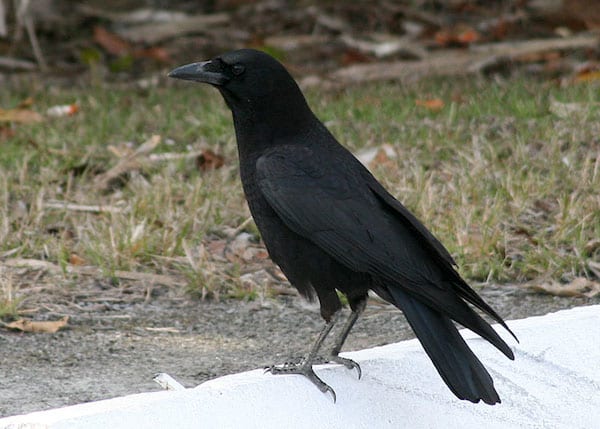Many backyard bird watchers struggle to identify certain birds. This is perfectly natural. Almost every bird watcher—even a seasoned pro—gets stumped once in a while by a fall-plumaged warbler or a confusing recent fledgling. The trick is to not let it ruin your fun in watching birds. Here are a few tips to help you get better at bird identification. These tips will work for you with the birds at your feeder and with the birds you’d encounter while hiking up Macchu Pichu. Doesn’t matter: bird ID is bird ID.

1. Practice with your binoculars.
Am I a master of the obvious or what? Still, you’ve got to admit that you’ve missed a bird or two because you couldn’t find it in your binoc. Or because you did not have your binocular pre-focused with the diopter properly set for the situation. Or maybe you found the bird but turned the focus wheel the wrong way.
I’ve made all these mistakes, and I’ve seen them made hundreds of times. It’s frustrating, because the bird you missed might have been something really special. Next time you’re out birding, take the time to practice the quick draw with your binoculars. Imagine a bird on a distant tree or power pole. Whip your binoc into viewing position and focus. How did you do? A little slow on the draw? You can’t get better at identifying birds if you’re not good at finding them in your binocular in the first place.
2. Leaf through the field guide.
Again, perhaps an obvious suggestion, but a few hours spent really looking at the illustrations and reading the species descriptions will help your knowledge base grow. You won’t remember everything, but what you do remember will surely help you the next time you are faced with an unfamiliar bird. Not all field guides are created equal, so choose the one or two that you prefer and spend some quality time with them.
3. Listen to bird song recordings.
This really helps. Of all the practicing that most bird watchers do, few of them spend enough time learning bird sounds, calls, and songs. These days this is easy with all the recordings and apps available. If you are not sure about to get started birding by ear, ask your fellow birders. Your region may have its own set of bird recordings.
Once you choose a set of recordings, I suggest you start with a group of birds, such as vireos or thrushes, rather than trying to tackle all the birds of North America at once. Larkwire.org turns learning bird sounds into a game.
4. Take advantage of cooperative birds.
Shorebirds are tough for me, especially the small sandpipers known as “peeps.” When I first sit down at a mudflat full of these small brownish shorebirds, they literally all look alike. But after I spend some time looking at one bird and noting its shape, behavior, general field marks, and then another bird, and another, some differences between the species begin to emerge.
Taking your time and taking advantage of cooperative birds is a great way to get better at bird ID. As you become a more careful, experienced observer, you will begin to know what to look for among groups of confusing birds, such as fall warblers, sparrows, or even peeps. The next challenge is to have regular encounters with these confusing species so that you don’t become rusty or forget what you’ve learned.
5. Start at the top of the head and work down and back.
You see an unfamiliar sparrow. It’s got lots of subtle field marks, almost too many to count. The best way to get a handle on the situation is to be methodical. Start at the top of the bird’s head and note any field marks there. Then work your way visually down to the breast/belly and back toward the bird’s tail, keeping track of notable field marks.
If there are a lot of field marks to remember, make a few notes or a quick sketch. If you get confused, start over. Most birds, especially most sparrows, can be identified by the field marks on the face and head. Look through the field guide and you’ll see what I mean.
6. Ask questions.
Any time you are with another bird watcher who is as good or better at bird identification, ask them questions. Not sure what to ask? One example might be, “How did you know that flying speck in the sky was a chimney swift?” More than 98 out of every 100 bird watchers will gladly answer you (and will be secretly flattered that you asked). The only bad question about bird identification is the one you don’t ask.
7. Keep a list.
There’s almost nothing I like better in bird watching than keeping a list of all the species I see in each of my sessions in our birding tower. It’s not so much help with identification as it is in seeing seasonally what to expect. This is how I knew, before raising my binoculars, that the little greenish-yellow bird wagging its tail in our lawn was probably a palm warbler.
I looked at last year’s tower nature notes and saw that the first week of October last year had a lot of palm warbler sightings. Knowing what you’re likely to see and when you’re likely to see it can help you make an identification more quickly.
8. Make notes and sketches.
It can be tough to tell a sharp-shinned hawk from a Cooper’s hawk. There are lots of clues and field marks outlined in the field guides, but I always had trouble remembering them until I took the time to write them down when I was at a hawk watch site with an experienced hawk watcher. She rattled off several ID tips and I wrote them in the back of my field guide.
I can still remember them to this day. Next to the words I drew a little sketch showing how the Cooper’s hawk’s head protrudes farther in front of the leading edge of the wings and the tail extends farther back from the trailing edge. Those two acts – writing and drawing – really helped cement the knowledge in my mental reference library.
9. Use memory devices.
Downy dinky, hairy huge. This is how I learned the difference between downy and hairy woodpeckers. It refers to the size of the bill relative to the size of the bird’s head. The alliteration helped this to stick in my brain. Memory devices work for field marks and for bird songs, too. That’s how I learned that the eastern (rufous-sided) towhee says “Drink your tea!”
10. Look at every bird.
Sure this can get boring, but it will make you familiar with the common birds more quickly, so when something unfamiliar shows up, you’ll know what it’s not. A corollary to this tip is to look at the bird, not at the book. The field guide will be there long after the bird flies away.





The main thing is being consistent in how you check out a bird’s markings, behavior, etc, because what catches your attention, is not necessarily how someone else does it, and trying to use somebody else’s pattern when their mind doesn’t work like your’s can be frustrating.